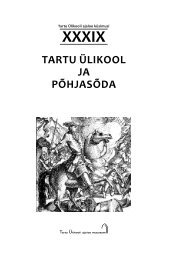TarTu ÜlIkool ja Põhjasõda - Tartu Ülikooli Ajaloo Muuseum
TarTu ÜlIkool ja Põhjasõda - Tartu Ülikooli Ajaloo Muuseum
TarTu ÜlIkool ja Põhjasõda - Tartu Ülikooli Ajaloo Muuseum
Create successful ePaper yourself
Turn your PDF publications into a flip-book with our unique Google optimized e-Paper software.
SirJe tamuL<br />
the right to award scientific degrees, a library and a printing-house,<br />
their own symbols and traditions typical of Protestant universities,<br />
peculiar customs of student life<br />
The golden age of development of German universities began in<br />
the last decade of the 17 th century: in 1694 Halle University was founded<br />
The process probably peaked in 1734/1737, with the opening of<br />
Göttingen University Those two universities were the examples for<br />
other German universities, achieving unprecedented leadership Immanuel<br />
Kant’s rhetoric about equality of the faculties (1798) paved<br />
the way for modern (state) universities where the faculty of theology<br />
was no longer dominant<br />
The struggle to implement the university idea in the Baltic Provinces<br />
lasted during the whole 18 th century, waged jointly by two factions:<br />
both the knighthoods and the old university towns of <strong>Tartu</strong><br />
and Pärnu demanded re-opening of the university In the meantime,<br />
those who could afford to do so, sent their sons to acquire knowledge<br />
in Germany. On 9 April 1798 Emperor Paul the First suspended<br />
the right of Russian subjects to study at foreign universities and,<br />
accordingly, he considered opening a new Russian state university<br />
Thus, in fear of the spreading ideas of the French Revolution, the emperor<br />
decided to implement the fourth clause of the 1710 capitulation<br />
documents of the Baltic Provinces that stipulated (re-)opening of the<br />
university The provinces now had an excellent opportunity to solve<br />
their university problem by implementing the imperial curriculum of<br />
higher education<br />
The university was re-opened in <strong>Tartu</strong> on 1 May 1802, after a<br />
92-year pause It should be noted that academic life in <strong>Tartu</strong> was<br />
resumed at a time when many German universities, including those<br />
in Halle, Jena and Göttingen, had been reorganised while numerous<br />
other German universities had been closed down Relying on the imperial<br />
privileges (Establishment Decree, 12 12 1802), the re-opened<br />
university in <strong>Tartu</strong> began implementing the new German-language<br />
university model, doing so about 7-8 years before this would be done<br />
in Germany itself, where the new model would become reality only<br />
with the opening of the Berlin University in 1810<br />
142



